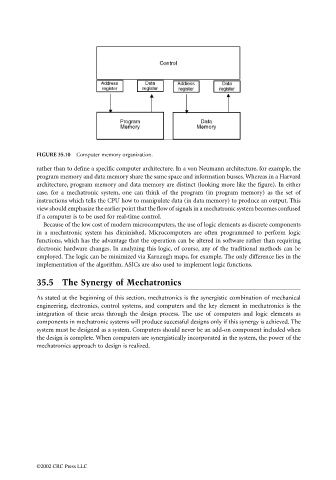Page 1031 - The Mechatronics Handbook
P. 1031
FIGURE 35.10 Computer memory organization.
rather than to define a specific computer architecture. In a von Neumann architecture, for example, the
program memory and data memory share the same space and information busses. Whereas in a Harvard
architecture, program memory and data memory are distinct (looking more like the figure). In either
case, for a mechatronic system, one can think of the program (in program memory) as the set of
instructions which tells the CPU how to manipulate data (in data memory) to produce an output. This
view should emphasize the earlier point that the flow of signals in a mechatronic system becomes confused
if a computer is to be used for real-time control.
Because of the low cost of modern microcomputers, the use of logic elements as discrete components
in a mechatronic system has diminished. Microcomputers are often programmed to perform logic
functions, which has the advantage that the operation can be altered in software rather than requiring
electronic hardware changes. In analyzing this logic, of course, any of the traditional methods can be
employed. The logic can be minimized via Karnaugh maps, for example. The only difference lies in the
implementation of the algorithm. ASICs are also used to implement logic functions.
35.5 The Synergy of Mechatronics
As stated at the beginning of this section, mechatronics is the synergistic combination of mechanical
engineering, electronics, control systems, and computers and the key element in mechatronics is the
integration of these areas through the design process. The use of computers and logic elements as
components in mechatronic systems will produce successful designs only if this synergy is achieved. The
system must be designed as a system. Computers should never be an add-on component included when
the design is complete. When computers are synergistically incorporated in the system, the power of the
mechatronics approach to design is realized.
©2002 CRC Press LLC

